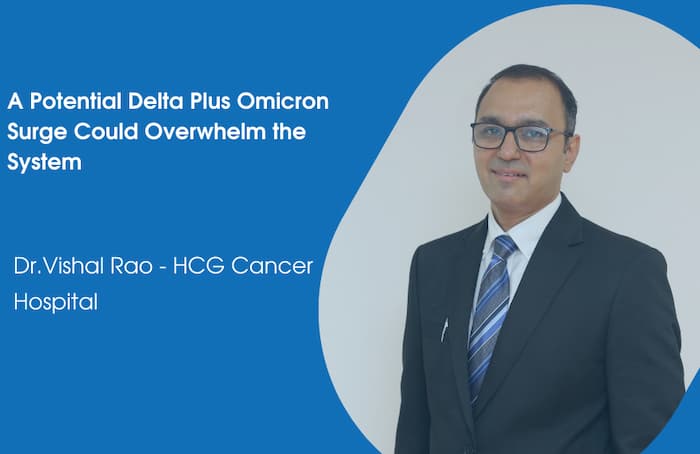
A Potential Delta Plus Omicron Surge Could Overwhelm the System, Says, Top Expert
The state is on the cusp of a massive third wave, with the expectation that thousands of infections will start to occur per day. An eminent oncologist and member of the state's Genomic Surveillance Committee, Dr Vishal Rao of HCG Cancer Hospital, tells DH's Akhil Kadidal that significant action is needed to prevent the surge in cases that could potentially overwhelm the system.
In six days, state-wide case numbers have jumped 127 per cent. What measures should be taken to contain the spread of COVID?
With COVID cases surfacing at a faster pace now, we need to acknowledge the historical realities of this virus. December 2019 saw the debut of the D614G variant. December 2020 saw the onset of the Delta variant, while December 2021 was the month of Omicron's advent. With every passing year, the virus seems to be getting smarter and stronger in terms of transmission, vaccine escape, and possibly even virulence. The race between vaccine and variant continues. So, we should not let our guard down and continue to keep our faith in vaccination, ventilation, masks, social distance, and hand hygiene. This will help us bring down the positivity rate.
At what rate is Omicron doubling?
The positivity rate of the Delta variant was 0.5 per cent in March 2021 but at the end of April, it touched 25 per cent. Now with Omicron, the doubling time is 1.5 to 3 days, so with Omicron plus Delta put together, the positivity rate of the Delta surge of 2021 can potentially be reached in half the duration it took in 2021. Hence, we will be forced to take stringent social distancing measures if and when we touch 5 per cent of the test positive rate.
Why is the test positivity rate so important?
The positivity rate needs to be correlated with the hospitalisation, ICU and oxygen bed rates. The example of South Africa needs to be looked at where hospitalisation and mortality rates were significantly lower in the case of the Omicron surge. While it was 25 per cent for Delta, it was 5 per cent for Omicron. Having said that, social curbs must continue unabated.
Should international flights be halted?
Yes, proactive thinking will be needed to forestall the third wave, especially through measures like halting international flights for a brief while. Although global studies have revealed that international flight bans are not very effective in virus control, flights and airports are breeding grounds for mixtures of variants and virus transmission. Hence, increased vigilance and monitoring at airports are a must. Needless to say, the citizen's role remains pivotal. We know that the virus does not move on its own; we help move it. If we move higher than 5 per cent, the government will also have to look at curbing the economic (activity) zones.
Is there anything the government should be considering at its meeting on Tuesday?
At this juncture, it is crucial to look at clusters and syndromic approaches. Considering that not every case will be symptomatic, it will be prudent to impose curbs based on hospitalisation rates, not merely positivity rates. Social and cultural activities can be allowed in a restricted manner, exercising ample caution. This will be advisable rather than adopting a blanket ban approach. Further, attention to needy patients on priority will be crucial.
Would a lockdown be necessary?
Generally, a lockdown is a mandate of last resort. It cannot be a treatment for any epidemic or pandemic. As the earlier two waves have taught us, the five Ts of testing, tracing, treating, training, and teamwork are very effective. In my personal opinion, we don't need lockdowns at this stage, unless hospitalisation rates become significant. The lockdown during the Delta wave happened when the government could not manage people's behaviour, and bed arrangements in hospitals were completely overwhelmed.
Studies show that Omicron may have lower disease severity. Is that something we can actually take comfort from?
While the severity of Omicron has been on the lower side, the WHO has rightly cautioned the world about its high transmission rate and mutational burden. A Hong Kong study has indicated that Omicron has a much lesser multiplication rate in the lungs. This could co-relate to milder disease of less severity. In parallel, we have data from Glasgow University that omicron is trying to alter the route of its entry into the cell. Does that mean it is weakening? Experts caution us that the Omicron may make alterations of different tipping points and hence making drastic assumptions would be highly dangerous.
Testing has been low in the state for at least six weeks. At what levels should we be testing currently?
In the coming days, testing rates would need to increase significantly. Higher number of rapid antigens and PCRs would need to be made to make diagnosis quicker, given that Omicron has a higher viral load. The first testing statistic we see anywhere is the number of tests conducted every day. This number alone doesn't tell us much, as the number of tests that may suffice for a smaller state like Goa may not be adequate for a bigger state like Maharashtra. Also, a state like Delhi, with a bigger epidemic, will require more tests per day irrespective of the size of its population. The raw number of daily tests must then be seen in the context of the population in a given area (tests per million) or the scale of the epidemic (test positivity rate)
Genomic sequencing continues to be low. But considering the surge in cases do you think that Omicron may be driving the increase in the case numbers? Should we be concerned about a Delta plus Omicron third wave?
The genomic surveillance team would gear up in no time, given the rising number of cases. The state government has given the necessary support in this direction.